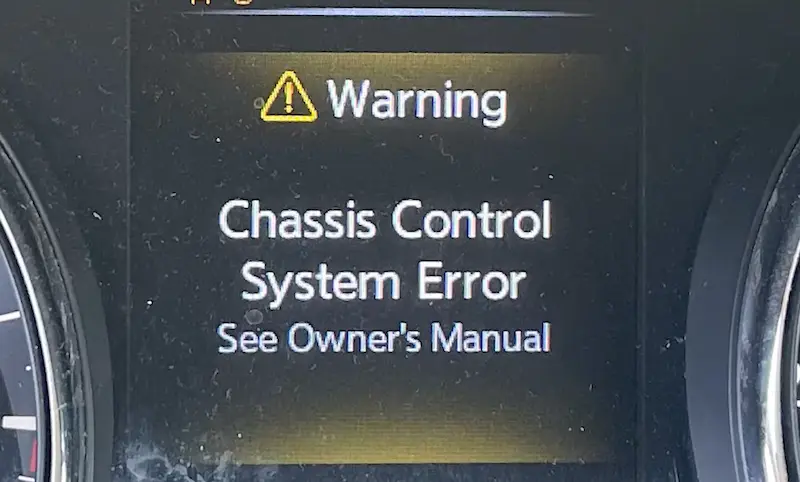A chassis control system error can be quite concerning, as it plays a crucial role in your driving experience. This advanced technology, specific to Nissan cars, includes active trace control, active engine braking, and active ride control, providing improved handling and comfort.
Usually, when you encounter a chassis control system error, your vehicle gathers data from various sensors, such as wheel speed sensors. It’s essential to address this issue promptly to ensure your car continues to operate efficiently and safely.
What is Chassis Control System
The Chassis Control System is an advanced feature found in some vehicles, such as the Nissan Rogue, that enhances your driving experience by improving stability, handling, and overall control. The system includes several components, such as active engine braking, active trace control, and active ride control, all working together to provide a more comfortable and confident driving experience.
When driving a car equipped with a chassis control system, you’ll notice some of its benefits, such as smoother cornering, better braking, and a more comfortable ride. The system does this by actively managing the suspension, braking, and steering to maintain optimal performance based on current driving conditions.
In the event of a chassis control system error, the vehicle’s module may have detected a fault in one or more of these components, leading to a communication issue between them. This issue could ultimately cause your car’s overall performance to decline.
To prevent such errors from occurring, it’s crucial to monitor your vehicle for any warning signs. Some common signs of chassis control failure include: a “Chassis Control System Error” warning message, steering tugging to one side, strange compressor sounds, rough riding, and variable tread wear.
If you experience any of these symptoms, it’s essential to address them promptly to maintain both your and your vehicle’s safety. Don’t hesitate to consult a professional mechanic for further assistance in diagnosing and repairing any problems related to the chassis control system.
Common Causes of Chassis Control System Error
In this section, we will discuss some common causes of chassis control system errors that you might encounter in your vehicle. Understanding these causes can help you address issues early and take appropriate action to maintain your vehicle’s safety and performance.
ABS Sensor Issues
One common cause of chassis control system errors is a malfunctioning ABS sensor. Your vehicle relies on ABS sensors to maintain stability during braking and maintain proper wheel speed. If an ABS sensor fails, it may lead to decreased handling, warning signs on your dashboard, and even chassis control system faults. To address ABS sensor issues, you can have your vehicle inspected by a qualified professional who will diagnose and repair the problem.
Wiring Harness Problems
Faulty wiring harnesses can also cause problems with your chassis control system. A damaged or loose wire can result in erratic signals, causing your vehicle to perform poorly or display warning messages. To resolve wiring harness issues, it is essential to inspect and repair any damaged or loose connections in your vehicle’s wiring systems.
Blown Fuse or Loose Battery Connection
A blown fuse or loose battery connection might be the culprit behind a chassis control system error. Ensure that you check the fuse box for any blown fuses and replace them if necessary. Additionally, ensure that your battery connections are secure, as a weak connection can cause multiple issues, including problems with your chassis control.
Sagging Suspension
A sagging suspension can be a sign of a chassis control system error. Issues such as a constantly running suspension compressor, uneven tread wear, difficulty in turning, or an unusually rough ride can indicate a problem with your suspension system. To fix a sagging suspension, it is important to have your vehicle inspected by a qualified mechanic and repair or replace any damaged components.
Corroded or Greasy Strut
Lastly, a corroded or greasy strut can lead to a chassis control system error. Over time, deteriorating struts can affect your vehicle’s handling and stability, impairing performance during acceleration, turning, and braking. Regularly inspecting and maintaining your struts will help prevent issues and ensure that your vehicle stays safe and reliable. If you discover any corroded or greasy struts, consult a professional mechanic for further assistance.
By identifying and addressing these common causes of chassis control system errors, you can maintain your vehicle’s safety and performance, ensuring a more enjoyable and reliable driving experience.
Diagnosing and Resetting Chassis Control System Error
Start Engine and Check Warning Messages
Before taking any drastic measures, start your engine and check if any warning messages display on the dashboard. Look out for messages like “Chassis Control System Error” and take note of any accompanying symptoms such as unusual noises, suspension sagging, or steering tugging to one side. These symptoms might indicate a problem with the chassis control system.
Consulting the Dealership
If the Chassis Control System Error persists, consider consulting your dealership or a certified technician for further assistance. They have the necessary tools and experience to diagnose the issue and suggest the best course of action. It’s essential to address the problem promptly to prevent more severe issues in the future.
Resetting the Chassis Control System Error
Here are some steps to reset the Chassis Control System Error:
- Turn off the engine and disconnect the battery: This step ensures that all electronic components are inactive before you begin working on the vehicle.
- Check the ABS sensor unit: An issue with the ABS sensor might be causing the chassis control error. Inspect, fix, or replace the ABS sensor unit if necessary.
- Inspect the ground lead: Check if the heavy black wire connecting the battery’s negative terminal to the chassis control system is securely connected and in good condition. Tighten or replace it if needed.
- Reconnect the battery and start the engine: After addressing any issues with sensors or connections, reconnect the battery and start the engine. Check if the Chassis Control System Error message has disappeared.
By following these steps, you can diagnose and reset Chassis Control System Error messages in your vehicle. Always prioritize safety and seek professional help if you are unsure about any part of the process.

